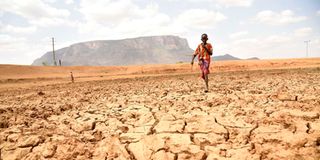Provide a permanent solution to drought

A herdsboy walks on a dry dam at Lerata in Samburu East in this picture taken on July 15, 2021.
President Uhuru Kenyatta recently declared drought a national disaster. In his press statement, he said most parts of the counties in the North have been affected by severe drought over the past few months.
Even as the country battles the Covid-19 pandemic, close to 1.4 million people are staring at starvation, especially in the North. With no food and water, human life is at risk, affecting labour, hence economic depreciation. Nobody can work without food and water. That means industries in the areas could collapse.
In 2016, severe drought in the arid and semi-arid land (Asal) areas as a result of failed rains affected almost 2.7 million people.
Droughts are unpredictable and can last for more than a year. The government has to take measures to curb more deaths.
Kenya Institute of Public Policy research shows that, of the 46 million Kenyans, 14.5 million face food insecurity and poor nutrition every year. There is, therefore, a need for a lasting solution.
The government should set up irrigation schemes in the northeastern region and around water bodies such as Lakes Turkana, Baringo, Victoria and Naivasha. The National Cereals and Produce Board (NCPB) should give the farmers drought-tolerant and -resistant crops such as sorghum, millet and green grams, which can withstand rain failure. It should also supply fertiliser.
Most Asal areas are windy. Wind is a cost-effective source of clean energy. The use of windmills that convert wind energy into rotational energy can pump water from the lakes that can be directed to tanks installed at strategic points. Windmills can also be installed to supply the energy needed to grind the grain after harvesting.
The government can also set up greenhouses, where farmers can grow vegetables such as spinach and carrots. The greenhouses can benefit from the irrigated water.
Bill Otieno, Migori
* * *
Pregnant women, nursing mothers and children should be given priority as the government and the World Health Organization chip in to assist those affected by drought in the country.
These groups are vulnerable as regards maternal and child healthcare basic requirements. Their health should be keenly monitored, more so now as they are faced with a disaster that could hinder them from accessing antenatal, delivery and postnatal healthcare services.
Getting their basic needs of survival like food and water is also at risk at the moment. The ministry of health should ensure that their health records are constantly monitored by mobilising community health workers.
This will keep the Ministry of Health updated on what is happening and work harmoniously with disaster management organisations and government agencies to ensure the vulnerable access basic needs.
Mercy Nzambi, Kisumu




